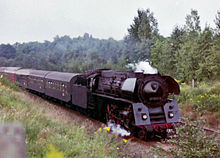Kettle crack in Bitterfeld
The boiler crack in Bitterfeld on November 27, 1977 was the last boiler explosion of a steam locomotive in Germany . Nine people died in the process.
Starting position
The regular locomotive of the express train D 567 from Berlin-Schöneweide to Leipzig Hauptbahnhof , a class 03 locomotive , had already become damaged and unusable on the outward journey to Berlin due to a lack of water. Therefore, in had depot of Berlin Ostbahnhof stationed steam locomotive 01 1516 are used. It had only returned from a general inspection a few days earlier from the Meiningen Reichsbahn repair shop and was assigned as a reserve locomotive . Now she was earmarked for this service at short notice. The locomotive service management informed the locomotive staff that the locomotive had to be replenished.
the accident
In the meantime it was a major delay . Only coal , but no water, was taken in, but the engine management was informed that the supplies were completely replenished. Also on the route there was no stop for water intake.
In the case of a steam locomotive, a safety bolt or a fusible plug is intended to prevent the boiler from overheating and thus prevent the boiler from cracking. The bolt is located above the furnace and melts when the furnace overheats. Through the opening released in this way, water flows from the boiler into the furnace and extinguishes it. However, the locomotive's safety bolt was so heavily sintered with lime that even though it melted, no water flowed into the furnace. It remained a mystery how this could happen, even though the locomotive had only returned from a general inspection a few days earlier from the Meiningen repair shop.
The investigation committee found that the water supply in the tender was completely used up. The material examination of the fire box showed that it had been heated to approx. 740 ° C. In order to reach these temperatures in the material, the fire box ceiling had to not have been covered with water for at least four minutes. At such a temperature the strength of the firebox dropped from 510 N / mm² to less than 88 N / mm².
The water level in the boiler had sunk so low that the remaining water initially ran forward when braking for the scheduled stop at Bitterfeld station and, when the locomotive stopped, sloshed back against exposed overheated parts of the heating surface. The water evaporated explosively . The roof of the fire box tore open, the machine's boiler popped and hurled the cab away. At the same time it turned, and the embers from the cauldron hit a passenger train arriving on the neighboring track, from which two cars caught fire. The boiler hit about 40 meters from the locomotive.
consequences
The engine driver and the stoker were killed. By flying splinters and debris, seven other people were killed and 45 people were injured at Bitterfeld station.
The platform roof and 60 meters of overhead contact line were damaged.
See also
swell
- A sad chapter in the history of the railway - accidents at the railways at the DR and DB after the Second World War: November 27, 1977 - the kettle crack of locomotive 01 1516 in Bitterfeld , photos of the destroyed locomotive.
- Hans-Joachim Ritzau , Jürgen Höstel : The catastrophe scenes of the present = railway accidents in Germany Vol. 2. Pürgen 1983. ISBN 3-921304-50-4 , p. 182.
Web links
- Report of the then investigative expert on the course of the accident on YouTube , accessed on October 22, 2019
- Photo of the destroyed 01 1516-2 .
- Photo of the destroyed 01 1516-2
Remarks
- ↑ Ritzau assumes 8 dead.
Individual evidence
- ↑ Ritzau.
Coordinates: 51 ° 37 ′ 17.1 ″ N , 12 ° 19 ′ 0.4 ″ E
